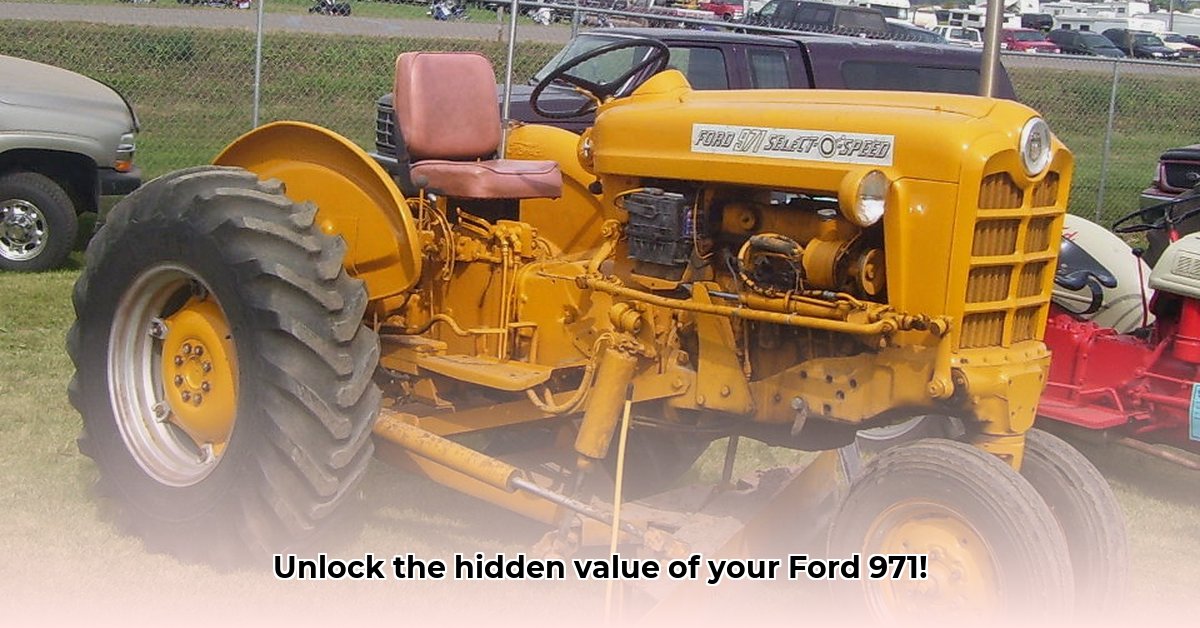
Ford 971 Tractor: A Collector's Deep Dive
The Ford 971 Powermaster tractor, a stalwart of Ford's agricultural machinery line, represents more than just a vintage farming implement; it embodies a pivotal moment in agricultural technology. Produced in numbers exceeding 300,000, its widespread adoption speaks to its groundbreaking features. The innovative Select-O-Speed transmission, a hydraulic marvel for its time, offered farmers the equivalent of an automatic transmission, significantly increasing efficiency. This, coupled with the independent power take-off (PTO) – allowing operation of implements without interrupting the main drive – revolutionized farming practices. This wasn't simply an incremental improvement; it was a paradigm shift, comparable to the transition from rotary phones to smartphones. For more Ford tractor info, check out this helpful resource.
Did you know that the Ford 971's design innovations significantly reduced labor, subsequently increasing productivity for farmers? This technology boost is a key factor influencing its collector value today.
The Ford 971 Tractor Market: A Shifting Landscape
Determining the current market value of a Ford 971 tractor is complex, with several key factors impacting its price. Condition is paramount; a meticulously restored tractor commands a significantly higher price than one neglected for decades. Parts availability presents another critical challenge. The difficulty of sourcing replacement parts for this vintage machinery directly influences restoration costs and ultimately, the sale price. Regional variations in collector interest also play a significant role; a highly sought-after model in one area may receive less attention elsewhere. Successfully navigating this market requires careful research and astute judgment.
Is the increasing scarcity of parts driving up the value of Ford 971 tractors? The answer is a resounding yes. This scarcity creates a high demand and affects the overall valuation among collectors.
Evaluating Your Ford 971 Tractor: A Step-by-Step Guide
Accurately assessing the value of your Ford 971 requires a comprehensive evaluation. Follow these steps:
Condition Assessment: Conduct a thorough inspection, documenting wear, tear, rust, or damage with detailed notes and photographs. This meticulous record-keeping is crucial for accurate valuation.
Completeness Evaluation: Original, unrestored tractors, especially those accompanied by original manuals, tools, and accessories, hold significantly higher value. The preservation of originality is a key factor in the collector's market.
Mechanical Inspection: A qualified mechanic specializing in vintage tractors should thoroughly inspect the engine and, critically, the Select-O-Speed transmission. A professional assessment minimizes costly surprises. Do not underestimate the importance of this step.
Market Research: Analyze online marketplaces and auction results for recently sold comparable Ford 971 tractors, paying close attention to their condition and sale prices to establish a realistic benchmark. This data-driven approach is essential for informed decision-making.
How can I find a reliable mechanic specialized in restoring vintage Ford tractors? Online forums dedicated to classic tractors and local agricultural societies are excellent resources for finding qualified mechanics within your region.
Ford 971 Tractor: Understanding the Risks
The age of the Ford 971 tractor introduces inherent risks. The Select-O-Speed transmission, revolutionary for its time, represents a potential point of failure.
| Feature | Risk Level | Mitigation Strategies |
|---|---|---|
| Parts Availability | High | Cultivate relationships with specialized vintage tractor parts suppliers. |
| Restoration Complexity | Medium-High | Engage experienced restoration professionals; this is a costly but potentially crucial investment. |
| Mechanical Failure | Medium | Implement a rigorous preventative maintenance schedule. |
Ford 971 Tractor: Long-Term Value and Prospects
The long-term value of a Ford 971 is influenced by several dynamic factors. Increasing collector interest may drive prices upward, particularly for exceptionally well-preserved tractors. However, the availability of parts and the expertise needed for maintenance remain crucial considerations. Owning a Ford 971 represents an investment in agricultural history and engineering, but also requires a commitment to ongoing care and maintenance.
What are the most significant factors that can negatively affect the long-term value of a Ford 971? Neglecting maintenance and a lack of readily available repair parts are the top concerns that can negatively affect the long-term value.
Actionable Steps for Ford 971 Owners and Enthusiasts
Regardless of your experience level, these steps will help you maximize your investment:
Thorough Research: Conduct comprehensive market research, understanding factors influencing value and parts sourcing.
Community Engagement: Network with fellow enthusiasts and experts through online forums and clubs to share knowledge and experiences.
Preventative Maintenance: Implement a proactive maintenance schedule to prevent minor issues from escalating into costly repairs.
Strategic Restoration: If restoration is necessary, develop a realistic budget and consider engaging experienced professionals.
The Ford 971 tractor transcends its function as mere machinery; it represents innovation and a significant milestone in agricultural history. By understanding its value and the factors that shape it, collectors can effectively appreciate and preserve this important legacy.
How to Restore a Ford 971 Select-O-Speed Transmission (Detailed Guide - Coming Soon)
A detailed, step-by-step guide to restoring the Ford 971 Select-O-Speed transmission will be available in a future publication. This guide will cover assessment, parts sourcing, disassembly, cleaning, repair, reassembly, and ongoing maintenance. Stay tuned for this comprehensive resource.